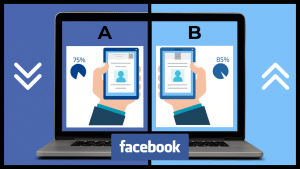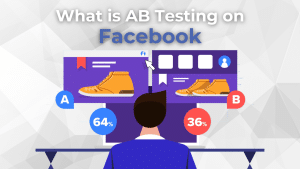Do you want to maximize the impact of your Facebook ads?
You can unlock the full potential of your Facebook ads with A/B testing. A/B testing for Facebook ads is a strategy that allows you to test the effectiveness of your ads to make data-driven decisions.
This article will explore the ins and outs of A/B testing for Facebook ads.
What is A/B Testing Facebook Ads?

A/B Testing is a method that involves creating two or more versions of an ad to determine which performs better. By comparing the results of different ad sets, you can make informed decisions to optimize your campaigns and maximize their effectiveness. Think of it as a digital experiment to find the winning combination that resonates most with your audience.
How To A/B Test Facebook Ads
With A/B Testing, you can figure out what works best for your audience. Follow the steps below to test several ad copy variations:
Step 1: Go to Facebook Ads Manager.
Firstly, sign in to your Facebook account. Then, navigate to your Facebook Ads Manager dashboard to find the campaign you want to test or set up a new campaign to get started.
Step 2: Outline your goal.
Before you start your A-B testing, clarify your objective. Ask yourself, “What do I want to achieve?” A clear goal will guide you through the testing process, whether it’s more clicks, likes, or conversions.
Step 3: Choose the ad set to test.
Select the elements you want to test in your ads. Keep it simple; headlines, ad copy, background images, or buttons are great places to begin. Remember, the goal is to isolate one variable at a time.
Step 4: Create your variants.
Duplicate your original ad and make a small change in each variant.
Step 5: Maintain consistency.
Keep all other factors consistent between the original and variant ads.
Step 6: Set a timeframe.
Decide how long your A B test will run. Facebook recommends a minimum of three to seven days to capture different user behaviors throughout the week.
Step 7: Split the budget fairly.
Divide your budget evenly between the original and variant ads.
Step 8: Launch your campaign.
Once you’ve configured your ad sets, budgets, and schedules, it’s time to launch your campaign.
Step 9: Monitor the results.
Monitor key metrics on your Ads Manager Dashboard for clicks, impressions, and conversions. These will be your indicators of success.
Step 10: Choose your winner.
After your test concludes, compare the test results. The ad with better performance in your chosen metric is the winner.
Step 11: Apply the lessons.
Implement the insights gained from your A B test into your future ad campaigns.
Step 12: Re-strategize and repeat.
Regularly conduct A-B tests to stay ahead of the curve and ensure your Facebook ads continue to capture attention.
Benefits of A/B Testing Facebook Ads
A/B testing on Facebook empowers advertisers to fine-tune their strategies. It ensures each ad campaign is a step closer to achieving its goals. Here are some reasons you should adopt this strategy:
- Optimized performance: It helps you to pinpoint the most effective ad elements to boost overall campaign performance.
- Data-driven decisions: It enables you to make informed choices based on real audience reactions and preferences.
- Cost efficiency: You maximize your ad budget by investing in what works and eliminating less effective elements.
- Improved conversions: It increases the likelihood of user actions like clicks, sign-ups, and purchases through targeted optimizations.
- Enhanced audience understanding: It provides insights into your audience’s preferences, enabling better ad personalization.
- Continuous improvement: You iteratively refine ads to adapt to changing trends and audience behavior.
Other Methods for Split Testing Facebook Ads

While A/B testing is a fantastic tool, there are alternative methods that can improve your Facebook ad experiments. Below are alternative options for split-testing ads on Facebook:
1. Geo-split testing.
Location matters and Geo-split testing helps you leverage this fact. Instead of testing different elements, run the same ad in different geographic locations. This method is especially handy if your product or service has regional nuances. Discovering which locations respond best to your ads can fine-tune your targeting strategy.
2. Time-based testing.
People’s online habits can change with the time or day of the week. With time-based testing, you experiment with running the same ad at different times to pinpoint when your audience is most receptive. Understanding the best timing for your ads can significantly boost their effectiveness, whether early morning or late at night.
3. Ad placements testing.
Not all ad placements are created equal. Experiment with displaying your ads in various positions across Facebook, from the news feed to the right column or even on Instagram. Understanding where your audience engages the most helps you optimize your ad placements for maximum impact.
Conclusion
A/B testing is an excellent strategy for making your Facebook ads more effective. By embracing experimentation and analyzing results, you get the data you need to improve your ads. You can also try other split testing methods like geo-split testing, time-based testing, and ad placements testing.
Would you like to run a Facebook ad campaign? Contact the top-tier ad agency on Facebook.
Frequently Asked Questions
What is A/B testing in the context of Facebook ads?
A/B testing, or split testing, is used in digital marketing, particularly on platforms like Facebook.
Why is A/B testing important for your Facebook ads?
A/B testing is crucial for Facebook ads because it provides valuable insights into what works and what doesn’t. It allows advertisers to make data-driven decisions by comparing the performance of different ad elements.
What are the key elements to test in a Facebook ad A/B test?
The key elements to test in a Facebook ad A/B test include headlines, ad copy, images, call-to-action buttons, and targeting options.
Related Articles
How to Use Facebook Event Marketing
